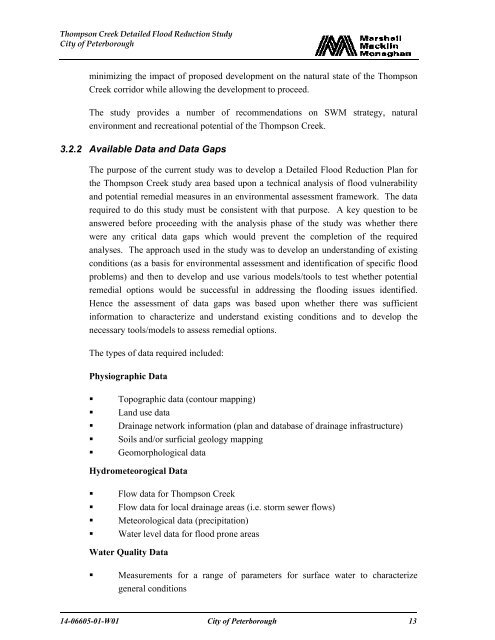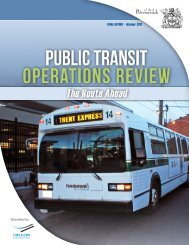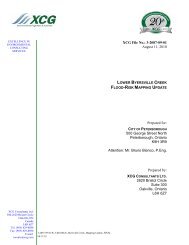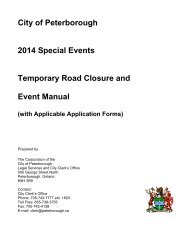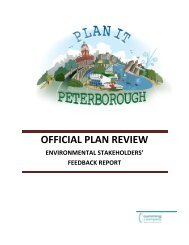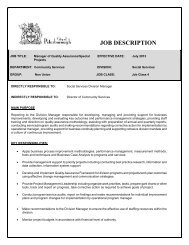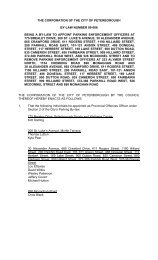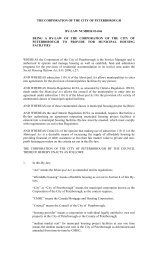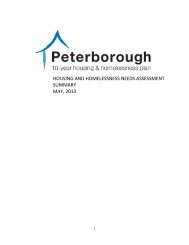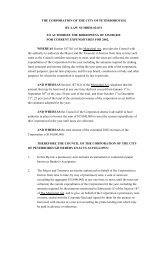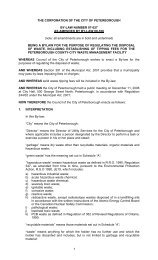Thompson Creek Flood Study Report - City of Peterborough
Thompson Creek Flood Study Report - City of Peterborough
Thompson Creek Flood Study Report - City of Peterborough
You also want an ePaper? Increase the reach of your titles
YUMPU automatically turns print PDFs into web optimized ePapers that Google loves.
<strong>Thompson</strong> <strong>Creek</strong> Detailed <strong>Flood</strong> Reduction <strong>Study</strong><br />
<strong>City</strong> <strong>of</strong> <strong>Peterborough</strong><br />
minimizing the impact <strong>of</strong> proposed development on the natural state <strong>of</strong> the <strong>Thompson</strong><br />
<strong>Creek</strong> corridor while allowing the development to proceed.<br />
The study provides a number <strong>of</strong> recommendations on SWM strategy, natural<br />
environment and recreational potential <strong>of</strong> the <strong>Thompson</strong> <strong>Creek</strong>.<br />
3.2.2 Available Data and Data Gaps<br />
The purpose <strong>of</strong> the current study was to develop a Detailed <strong>Flood</strong> Reduction Plan for<br />
the <strong>Thompson</strong> <strong>Creek</strong> study area based upon a technical analysis <strong>of</strong> flood vulnerability<br />
and potential remedial measures in an environmental assessment framework. The data<br />
required to do this study must be consistent with that purpose. A key question to be<br />
answered before proceeding with the analysis phase <strong>of</strong> the study was whether there<br />
were any critical data gaps which would prevent the completion <strong>of</strong> the required<br />
analyses. The approach used in the study was to develop an understanding <strong>of</strong> existing<br />
conditions (as a basis for environmental assessment and identification <strong>of</strong> specific flood<br />
problems) and then to develop and use various models/tools to test whether potential<br />
remedial options would be successful in addressing the flooding issues identified.<br />
Hence the assessment <strong>of</strong> data gaps was based upon whether there was sufficient<br />
information to characterize and understand existing conditions and to develop the<br />
necessary tools/models to assess remedial options.<br />
The types <strong>of</strong> data required included:<br />
Physiographic Data<br />
<br />
<br />
<br />
<br />
<br />
Topographic data (contour mapping)<br />
Land use data<br />
Drainage network information (plan and database <strong>of</strong> drainage infrastructure)<br />
Soils and/or surficial geology mapping<br />
Geomorphological data<br />
Hydrometeorogical Data<br />
<br />
<br />
<br />
<br />
Flow data for <strong>Thompson</strong> <strong>Creek</strong><br />
Flow data for local drainage areas (i.e. storm sewer flows)<br />
Meteorological data (precipitation)<br />
Water level data for flood prone areas<br />
Water Quality Data<br />
<br />
Measurements for a range <strong>of</strong> parameters for surface water to characterize<br />
general conditions<br />
14-06605-01-W01 <strong>City</strong> <strong>of</strong> <strong>Peterborough</strong> 13


